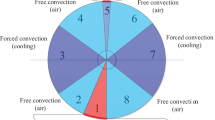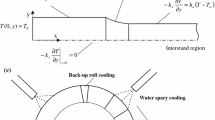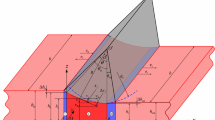Abstract
A mathematical model was developed to assess thermomechanical behavior of work rolls during warm rolling processes. A combined finite element analysis-slab method was first developed to determine thermal and mechanical responses of the strip being rolled under steady-state conditions, and then, the calculated roll pressure and temperature field were utilized as the governing boundary conditions for the thermomechanical problem of the work roll. Finally, the thermomechanical stresses within the work rolls were predicted by a thermoelastic finite element approach. The results of the model indicate that, in warm strip rolling, thermal and mechanical stresses developed in the work rolls are comparable, and thus, both thermal and mechanical aspects of the problem should be considered in such a problem. Besides, the model was shown to be capable of determining the effects of various rolling parameters on the thermomechanical behavior of the work rolls during warm rolling process.











Similar content being viewed by others
References
J.J.M. Too: International Journal for Numerical Methods in Engineering 1990 vol. 30, pp.1699-1718.
C. Liu, P. Hartley, C. E. N. Sturgess and G. W. Rowe: International Journal of Mechanical Sciences, 1985 vol. 27, pp. 829-839.
M. Pietrzyk and J. G. Lenard: International Journal for Numerical Methods in Engineering, 1990, vol. 30, pp. 1459-1469.
W. B. Lai, T. C. Chen and C. I. Weng: Computational Mechanics, 1991, vol. 9, pp. 55-71.
P. Gratacos, P. Montmitonnet, C. Fromholz, and J. L. Chenot: International Journal of Mechanical Sciences, 1992, vol. 34, pp. 195-210.
A. A. Teseng, F. H. Lin, A. S. Gunderia, and D. S. Ni: Metall. Trans 1990, vol. 20A, pp. 2305–2320.
S. M. Hwang, C. G. Sun, S. R. Ryoo, and W. J. Kwak: Computer Methods in Applied Mechanics and Engineering, 2002, vol. 191, pp. 4015-4033.
L. M. Galantucci and L. Tricarico: Journal of Materials Processing Technology, 1999, vols. 92-93, pp.494-501.
R. S. Prakash, P. M. Dixit, and G. K. Lal, Journal of Materials Processing Technology 1995, vol.52, pp. 338-358.
A. F. M. Arif, O. Khan and A. K. Sheikh: Jounrnal of Material Processing and Technology 2004, vol. 147, pp. 255–267.
M. T. Wang, X. L. Zang, X. T. Li and F. S. Du: International Journal of Iron and Steel Research, 2007, vol. 14, pp. 30-36.
M. P. Phaniraj, B. B. Behera and A. K. Lahiri, Journal of Materials Processing Technology, 2005, vol.170, pp. 323-335.
H. Sheikh: Applied Mathematical Modelling, 2009, vol. 33, pp. 2187–2195.
S. Serajzadeh: Materials Science and Engineering A, 2004, Vol. 371, pp. 318-323.
A. Sonboli and S. Serajzadeh: Materials Science and Technology, 2010, vol. 26, 343–351.
D.F. Chang: Journal of Materials Processing Technology, 1999, vol. 94, pp. 45–51.
F. D. Fischer, W. E. Screiner, E. A. Werner, and C. G. Sun: Journal of Materials Processing Technology, 2004, vol. 150, pp. 263–269.
C. G. Sun, C. S. Yun, J. S. Chung, and S. M. Hwang: Metallurgical and Materials Transactions 1996, vol. 29A, pp. 1998-2407.
J. C. Heinrich and D. W. Pepper, Intermediate finite element method- Fluid flow and Heat Transfer Applications, Taylor & Francis, Philadelphia, 1999.
P.M. Dixit and U.S. Dixit. Modelling of Metal Forming and Machining Processes by Finite Element and Soft Computing Methods. Springer, U.K., 2008.
P.L. Charpentier, B. C. Stone, S.C. Ernst, and J.F. Thomas: Metall. Trans., 1984, vol. 17A, pp. 1986-2227.
R. Hill: Journal of the Mechanics and Physics of solids, 1963, vol. 11, pp. 305-326.
S.J Chen and A.A. Tseng: Int. J. Heat Fluid Flow 1992, vol. 13, pp. 358–69.
J. D. Lee, M.T. Manzari, Y.L. Shen, and W. Zeng: Trans. ASME J. Manuf. Sci. Eng. 2000, vol. 122, pp. 706–16.
F.L. Stasa. Applied Finite Element Analysis for Engineering. Japan CBS Publishing, 1985.
J. Chakrabarty, Theory of Plasticity, McGraw-Hill, New York, 1987.
V. B. Ginzburg, Flat rolled steel processes: Advanced technologies, CRC Press, US, 2009.
Metals Handbook: Properties and Selection: Nonferrous Alloys and Special-Purpose Materials: 10th ed, ASM International, 1990.
Author information
Authors and Affiliations
Corresponding author
Additional information
Manuscript submitted April 15, 2011.
Rights and permissions
About this article
Cite this article
Khalili, L., Serajzadeh, S. & Koohbor, B. Thermomechanical Behavior of Work Rolls During Warm Strip Rolling. Metall Mater Trans B 43, 1638–1648 (2012). https://doi.org/10.1007/s11663-012-9714-7
Published:
Issue Date:
DOI: https://doi.org/10.1007/s11663-012-9714-7




